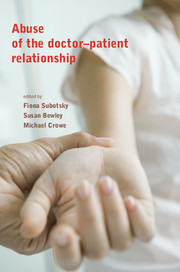Book contents
- Frontmatter
- Contents
- List of figures, tables and boxes
- List of contributors
- Foreword
- Introduction: mapping the territory
- 1 The ethical importance of boundaries to intimacy
- 2 The patient's perspective: impact and treatment
- 3 Teaching ethics and ethical behaviour to medical students
- 4 With the benefit of hindsight: lessons from history
- 5 The prevalence of boundary violations between mental health professionals and their clients
- 6 Psychiatry: responding to the Kerr/Haslam Inquiry
- 7 The general practitioner and abuse in primary care
- 8 Boundaries and boundary violations in psychotherapy
- 9 Sexual therapies: ethical guidelines, vulnerabilities and boundaries
- 10 Obstetrics and gynaecology: a special case?
- 11 Nurses as abusers: a career perspective
- 12 Medical management: governance and sexual boundary issues
- 13 Dealing with offending doctors: sanctions and remediation
- 14 Defending doctors: the protection society's experience
- 15 Regulation and its capacity to minimise abuse by professionals
- 16 The role of the General Medical Council
- Appendix 1 Extract from Vulnerable Patients, Safe Doctors
- Appendix 2 Codes of ethics of psychiatric associations in other countries
- Appendix 3 Guidance from the Council for Healthcare Regulatory Excellence
- Appendix 4 Examples of determinations by the General Medical Council's Fitness to Practise panels
- Appendix 5 Website resources and information
- Index
- Plate section
14 - Defending doctors: the protection society's experience
Published online by Cambridge University Press: 02 January 2018
- Frontmatter
- Contents
- List of figures, tables and boxes
- List of contributors
- Foreword
- Introduction: mapping the territory
- 1 The ethical importance of boundaries to intimacy
- 2 The patient's perspective: impact and treatment
- 3 Teaching ethics and ethical behaviour to medical students
- 4 With the benefit of hindsight: lessons from history
- 5 The prevalence of boundary violations between mental health professionals and their clients
- 6 Psychiatry: responding to the Kerr/Haslam Inquiry
- 7 The general practitioner and abuse in primary care
- 8 Boundaries and boundary violations in psychotherapy
- 9 Sexual therapies: ethical guidelines, vulnerabilities and boundaries
- 10 Obstetrics and gynaecology: a special case?
- 11 Nurses as abusers: a career perspective
- 12 Medical management: governance and sexual boundary issues
- 13 Dealing with offending doctors: sanctions and remediation
- 14 Defending doctors: the protection society's experience
- 15 Regulation and its capacity to minimise abuse by professionals
- 16 The role of the General Medical Council
- Appendix 1 Extract from Vulnerable Patients, Safe Doctors
- Appendix 2 Codes of ethics of psychiatric associations in other countries
- Appendix 3 Guidance from the Council for Healthcare Regulatory Excellence
- Appendix 4 Examples of determinations by the General Medical Council's Fitness to Practise panels
- Appendix 5 Website resources and information
- Index
- Plate section
Summary
Introduction
The Medical Protection Society (MPS) is a provider of professional indemnity and advice to doctors, dentists and health professionals around the world. It is a mutual, not-for-profit organisation that offers its members (who number more than 265 000) help with legal and ethical problems that arise from their professional practice. These include clinical negligence claims, complaints, medical council inquiries, legal and ethical dilemmas, disciplinary procedures, inquests and fatal-accident inquiries.
The MPS medico-legal advisers manage a substantial and varied caseload. The telephone advisory service fields more than 18 000 calls a year. This places the MPS and the other medical defence organisations (MDOs) in a unique position, as they are able to hear directly from practising clinicians how they are affected by allegations and subsequent investigations.
Scope
The doctor–patient relationship requires boundaries to function effectively. These same boundaries may at times be crossed, broken or perceived to be crossed or broken, often leading to the breakdown of the relationship. The General Medical Council (GMC) comments:
Trust is a critical component in the doctor–patient partnership: patients must be able to trust doctors with their lives and health. In most successful doctor– patient relationships a professional boundary exists between doctor and patient. If this boundary is breached, this can undermine the patient's trust in their doctor, as well as the public's trust in the medical profession. (GMC, 2006).
Just as there are many different types of boundary, so there are as many ways for doctors to find themselves on the wrong side. Such transgressions can have significant consequences for the immediate therapeutic relationship and for the doctor's working life in general. The threat to the wider public confidence in the profession has resulted in regulatory bodies taking boundary infringements extremely seriously.
It is sexual boundaries that are thought of most often. Doctors who commit sexual crimes against their patients clearly raise concerns about public confidence in the profession and attract extensive media attention, but there are many more common transgressions, for instance treating a family member or taking part in an apparently consensual sexual relationship with a patient.
- Type
- Chapter
- Information
- Abuse of the Doctor-Patient Relationship , pp. 164 - 176Publisher: Royal College of PsychiatristsPrint publication year: 2010

